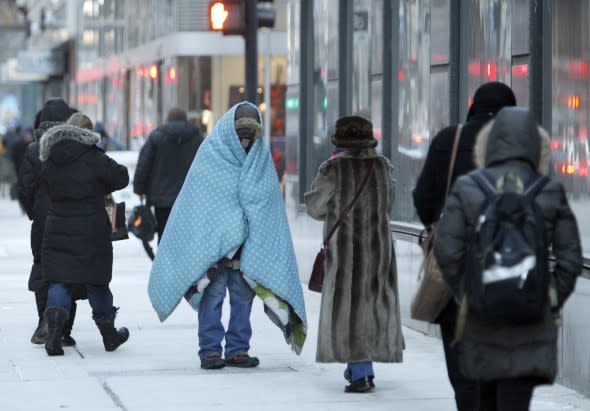How major cities are helping homeless populations during the polar vortex intrusion
As temperatures dip to record lows across the Midwest, millions are being advised to stay indoors. However, as this polar vortex invades major cities across the United States, what is done for those that can't escape into the house for warmth? What is done in major cities to help the homeless in this extreme cold?
New York, Washington, D.C., Boston and Chicago rank among the cities with the largest homeless populations according to the U.S. Department of Housing and Urban Development, and they are all being affected by this week's drastic temperatures.
Temperatures are competing with records throughout the United States as they drop lower than they have in recent history. These extreme temperatures are dangerous to be in for any extended period of time. Without the proper clothing, hypothermia can set in within the hour.

A homeless man who did not give his name bundles up in blankets Tuesday morning, Jan. 28, 2014, in downtown Chicago. (AP Photo/Kiichiro Sato)
All four cities have emergency plans in place that bring together city government, police, EMS, local shelters, veteran organizations and youth services. These plans go into action when temperatures dip below freezing. All these organizations share the same goal: get as many outdoor residents off the street as possible in this weather.
These cities, along with most other major cities, utilize the 3-1-1 non-emergency service number. In situations of extreme cold, city officials ask that you report the location of homeless people by calling this hotline. Through this service, officials have the ability to reach a greater number of people that remain outside.
Extreme cold consistently leads to crowded shelters throughout these major cities. Dora Taylor, public information officer at D.C.'s Department of Human Services, shared "our numbers almost double during a cold weather emergency. We average about 800 folks per shelter when we aren't in a cold snap and in severe weather we will be seeing 16 to 17,000 people overnight."
In cold weather, such as what cities are experiencing now, shelters in Washington, D.C., New York and Boston will not be turning people away. "These three cities are the only ones functioning with a Right To Shelter Law during a hypothermic event. We are legally bound to provide a warm safe space for someone during a hypothermia alert," Taylor said. This law ensures that before a shelter can completely overcrowd government officials are opening seasonal centers on a per need basis.
Thus far, Chicago has been most significantly affected from this week's blistering cold. Emergency preparation began Monday afternoon as the city attempted to place all homeless people in shelters or warming centers. They were almost immediately faced with overcrowding even as more shelters were opened and warming centers extended their hours.
The Chicago Transit Authority has begun deploying buses outside of shelters in order provide warmth to those unable to fit indoors.
Sad to see so many homeless still sleeping on the sidewalk, under overpasses around #Chicago#Chicagoweather#Polarvortex@accuweather@breakingweatherpic.twitter.com/EMDZmc0CzB
— Jonathan Petramala (@jpetramala) January 30, 2019
As the extreme cold closes in on New York, Washington, D.C., and Boston, the National Alliance to End Homelessness urges people to use the hotlines available to them to best assist those outside in the coming days.
Nan Roman, president and CEO of the National Alliance to End Homelessness, advises doing more than dropping off soup or delivering gloves.
"People have to do what they feel from their heart, but when it's this cold, you need to call someone and try to get first-responders to the person, not just assume that a coat or blanket will solve the problem," Roman said.
Often, people will try to avoid going to a shelter overnight because of past experiences they have had, lack of available space and the potential health risks associated with overcrowding. Dialing 3-1-1 can be helpful in this situation as emergency personal can provide multiple resources.

